
Raised beds in Pam’s yard.
What will you be growing in your garden this year?
Georgia’s red clay can be a challenge for gardeners. That’s why so many experts sing the praises of raised beds. You have more control over where you site your gardens; you can fill the beds with good soil instead of relying on what’s already present in your landscape; it’s a good way to keep weeds at bay; and raised beds are easier to reach with less bending down.
First, pick your location. It’s OK to disrupt a stretch of lawn if that’s where you have at least 6 hours of sun. We actually removed about 40 percent of our zoysia lawn to create more vegetable beds and now have ample room for tomatoes, okra, peppers hot and mild, plus one bed that’s dedicated to strawberries.
Use either 2-by-12 or two 2-by-8 pressure treated lumber to build rectangular beds no more than 3 feet wide. That way you can reach both sides for planting and harvesting. Fill the beds with packaged garden soil, amended with mushroom compost, black cow and organic material. To improve drainage, add about 15 percent vermiculite or perlite, available at garden centers in bulk bags.
If you’ve composted and kept the piles turned over the winter, you’ll have discovered gold: black gold. Add it to your garden beds. You can also use it to top-dress shrubs and perennials in your yard, where it will provide a good boost of nutrients.
Once you’ve added the soil to the beds, water it in well to allow it to settle and eliminate air pockets that can harbor diseases and insects.
Ready to plant
You may have started your tomato or pepper seeds indoors, but you can also purchase seedlings – vegetables to herbs to flowers – at local nurseries or box retailers. Perhaps you have a gardening friend who started seeds in January and February and now has an abundance of seedlings to share.
Seeds, such as squash, cucumber and beans, can be direct sowed into the garden when the soil temperature is 60 degrees or above. If you’re going to direct sow, remember that you’ll most likely need to thin the plants after they have sprouted at least two sets of true leaves. This allows room for the remaining plants to mature and bear.
Plant tomatoes as well, putting up your cages when you transplant your small seedlings. We use horse gate fencing to build sturdy cages, bending a piece into right angles length-wise, then cable-tying to 90-degree sections together to support the plants. Ours are at least six feet tall; the larger holes allow for picking inside the supports.
Remember to regularly water your raised beds. Stick your index finger into the soil and if it feels dry down to your first knuckle, it’s time to water. Feed your plants regularly too; they are busy using energy to produce your vegetables. To avoid burning the roots, use a slow-release type, such as Osmocote. If you’re using a granular fertilizer, apply every four to six weeks, being careful to apply at least 3-4 inches away from the base of the plant. Read package instructions before apply any fertilizer to ensure proper fertilization.
A word of caution
In our area, April 15 is generally the date of the last frost. But don’t trust Mother Nature. With the extraordinarily warm winter, we may be in for one last freeze. If you’re worried about your tender crops, purchase some frost cloth from a box retailer or online. Cover your young plants in the late afternoon if temperatures are predicted in the low to mid-30s. Remember to remove the cloth first thing the next morning; otherwise you’ll create a mini-greenhouse and your tender seedlings will get too warm.
Great garden resources:
joegardener.com – national gardening expert whose Growing a Greener World is broadcast on Georgia Public Television. A resident of North Georgia, he offers garden tips, interviews with garden experts across the country, podcasts and several online courses through his Online Gardening Academy at organicgardeningacademy.com.
University of Georgia Extension – Reach your local UGA Extension office at 1-800-ASK-UGA1 to connect with county extension offices staffed with Master Gardeners, or visit extension.uga.edu/publications.html and search for your gardening topic.
Photo: by Pamela A. Keene





